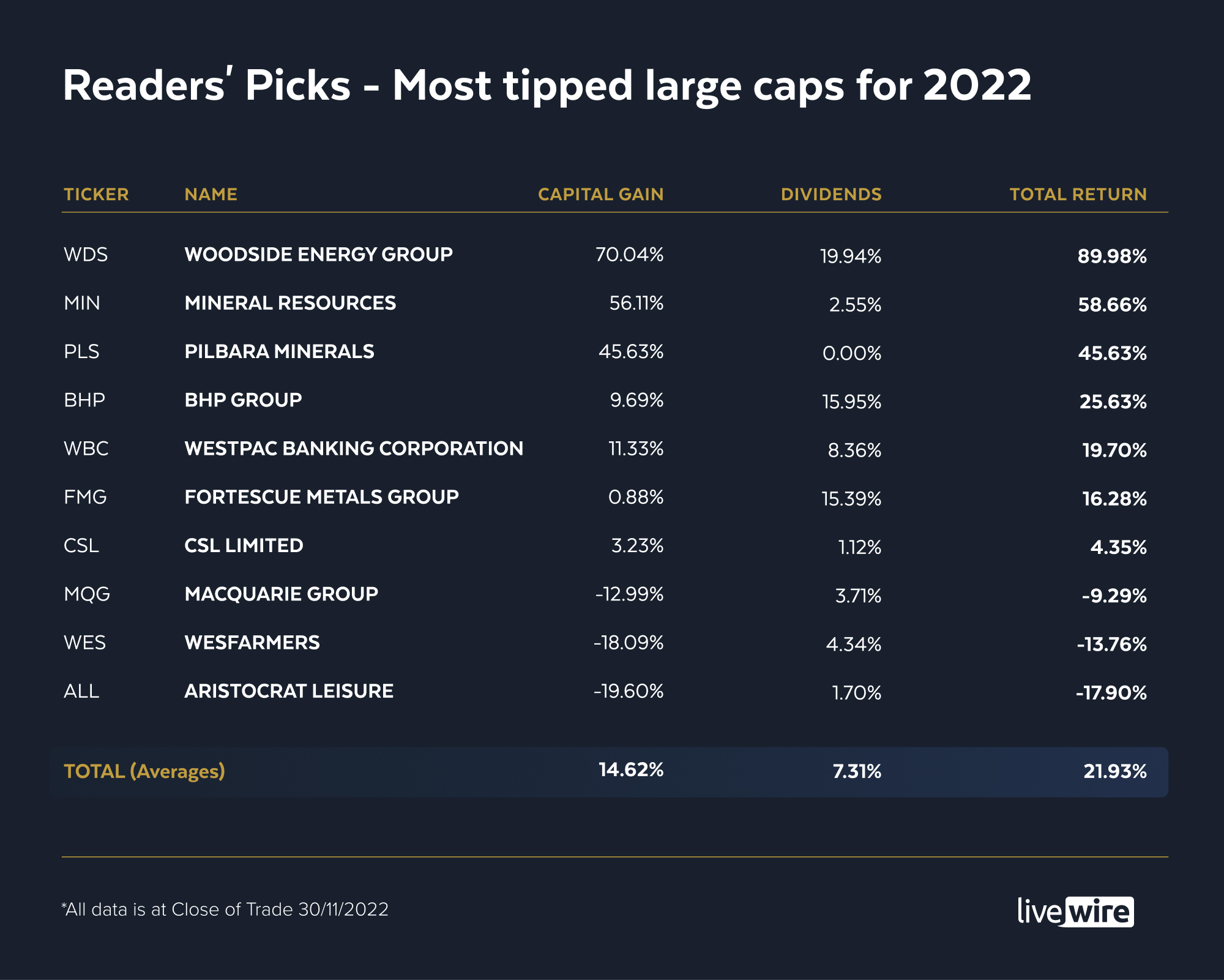Here's how the top-tipped large caps performed in 2022
To say it has been a tumultuous year in markets doesn't quite tell the whole story. At the end of November (the rule-off date for the analysis below), the ASX 200 was down 2.2%. It doesn't sound like a lot, but this year has been more about the journey than the destination.
In the past 11 months, we have seen yields do things they hadn't done since the early ’90s. Inflation has also behaved in ways not seen since the ’70s, and central banks have responded in kind by pulling the punch bowl and threatening a global recession.
The numbers are astounding when it comes to rate hikes. Courtesy of my colleague Hans Lee and T.Rowe Price, we know that there have been 274 rate hikes around the world since January 1 - for a total of more than 6700 basis points. By comparison, in 2020 there were just nine rate hikes globally.
Aside from central bank moves, we've also had to contend with a troubled European Union, the Ukraine War, an energy crisis, a wobbly China, tanking local property prices, and traditional asset relationships (stocks vs. bonds, for example) breaking down.
As these events impacted markets, one thing became clear. Quality, as a factor, rose to the top. In a year where style factors such as growth and value haven't particularly dominated, quality has stood up. And where do you typically find most 'quality' names? Towards the top end of town.
As such, it's largely unsurprising that your top-tipped large caps have produced some solid winners since they were picked by you, our valued readers, late last year in our Outlook Series survey. And while there have been some losers as well, this list looks a lot better than some of the other top-tipped lists.
In this wire, you learn how your top-tipped large caps performed for the first 11 months of 2022, from best to worst in performance (inclusive of dividends, capital gains and currency movements) as of the close of trade on November 30.
Make sure to keep an eye out for this year's survey, which we will publish next week. We can't wait to see what your picks will be for 2023!
Note: By publishing this list, we are sharing information from the Livewire readership that hopefully inspires further research ideas. This information is not, nor is it intended to be, a set of recommendations. Please do your own research and seek professional advice.
.jpg)
1. Woodside Energy Group (ASX: WDS)
- Market cap: $67.8 billion
- YTD total return: 89.98%
- Percentage of overall votes: 1.43%
What a year it has been for energy. The Ukraine War began in late February and oil prices were around US$92 per barrel. By 8 March, they were around US$124 per barrel. And whilst they have since pulled back to be trading around US$80 per barrel, we have an energy crisis in Europe unfolding and an uncertain global outlook.
Enter Woodside (ASX: WDS), which has gone from strength to strength. September quarter production and revenue beat expectations, whilst positives also came in the form of an upgrade to 2023 production guidance and lower capex.
Plato's Dr Don Hamson recently revealed he was backing Woodside as a sustainable dividend payer over the years to come.
"We like the energy stocks, and we like that outlook. And longer term, we think Woodside's a great stock," he said.
"It's got some quality assets. I know it's in fossil fuels, but gas and LNG are on the pathway to lower emissions. It'll help us get there. Obviously, it is benefiting from the Ukrainian crisis, but we think it's got a great dividend outlook for a number of years."
2. Mineral Resources (ASX: MIN)
- Market cap: $17.52 billion
- YTD total return: 58.66%
- Percentage of overall votes: 2.54%
MinRes performed very well in 2022, as well it should, given it is plugged into two of the hottest commodities in iron ore and lithium. Still, the company needed to execute effectively, and it has, whilst at the same time outlining a multi-pronged expansion strategy, including innovative solutions for mining services and growth in iron ore, lithium, and energy. The five-year plan focuses on significant volume growth, which should please investors.
Mineral Resources is the top holding in Romano Sala Tenna's Katana Australian Equity Fund, as he revealed recently in an interview with Livewire's Ally Selby.
He argues it boasts "one of the two largest hard rock spodumene mines in the world," and it doesn't hurt that it's also the largest contract crusher in the world - clipping the ticket on 300 million tonnes annually.
3. Pilbara Minerals (ASX: PLS)
- Market cap: $14.61 billion
- YTD total return: 45.63%
- Percentage of overall votes: 2.64%
Pilbara was a latecomer this year in terms of share price, doing nothing for the first six months and then climbing strongly since July. It has been another beneficiary of the lithium craze that swept the ASX this year, although, once again, management had to execute effectively. The company’s capital management framework has shown a disciplined approach to capital and some brokers now expect a maiden dividend in FY23.
But not everyone remains convinced. Eley Griffiths Group's Nick Guidera expects profit-taking in lithium names like Pilbara Minerals and Liontown Resources (ASX: LTR) over the coming months and is thus avoiding stocks like these.
4. BHP Group (ASX: BHP)
- Market cap: $237.49 billion
- YTD total return: 25.63%
- Percentage of overall votes: 2.54%
The Big Australian has had a solid year, with a total return of around 25%. Dividends make up the lion’s share of that, at 16%, proving again that our big miners are cash cows in the current environment. The question begs, of course, can they continue to be? Time will tell. As for the big news around BHP this year, it’s the $10 billion takeover of OZ Minerals. Due diligence is being conducted as we write this, and the OZL board is expected to endorse the offer once the binding schemed implementation agreement is received, with the deal completed by mid-2023.
According to Wheelhouse Partners' Alastair MacLeod, BHP is a buy.
"It's a very cyclical industry, but if you look forward three or four years, I think the expected dividend moves more towards AUD$2 a share, which is still about a 5% yield," he said.
"So from an income perspective, I think over the next couple of years it's a buy because of its a market-leading position, and that yield I think compensates for the cyclicality or the risk to earnings."
5. Westpac Banking Corporation (ASX: WBC)
- Market cap: $83.2 billion
- YTD total return: 19.7%
- Percentage of overall votes: 1.03%
The banks had a solid year, helped along by fatter net interest margins (NIMs) in a higher interest rate environment. Westpac was coming from a fair way back, given prior disappointing operational performance, and some analysts still see WBC’s share price as ‘attractive’. FY22 results showed higher-than-expected costs being offset by higher net interest income and a lower bad debt outlook.
Alastair MacLeod, from Wheelhouse Partners, recently called Westpac a BUY, saying “their opportunity from a cost-income perspective, it's one of the least profitable banks. They're targeting $8 billion in savings. We don't think they're going to quite get there, but even if they get close, it's providing a lot of earnings growth, which will feed through into EPS growth and dividend growth.”
6. Fortescue Metals Group (ASX: FMG)
- Market cap:$63.26 billion
- YTD total return: 16.28%
- Percentage of overall votes: 2.19%
This is another name for riding the commodities train. FMG enjoyed a 16.3% return, with 15.4% coming from dividends. Despite the solid performance this year, most brokers currently have an underweight rating on the stock, with many noting that CAPEX growth (and the blowout at Iron Bridge) will force Fortescue to cut its dividend payout ratio.
7. CSL Limited (ASX: CSL)
- Market cap: $144.7 billion
- YTD total return: 4.35%
- Percentage of overall votes: 5.01%
CSL is the last of the large caps tipped to post a positive return. The company is a perennial favourite of Livewire readers, and fair enough too. It’s one of the most prominent international companies Australia has ever produced. This year, CSL benefitted from the post-covid environment and finalised the near $17 billion Vifor deal.
8. Macquarie Group (ASX: MQG)
- Market cap: $70.36 billion
- YTD total return: -9.29%
- Percentage of overall votes: 4.31%
Another perennial favourite of Livewire Readers, Macquarie has posted a negative return of 9.29%, so far this year, though I doubt that I will deter the true believers.
Recent results were stronger than many analysts expected, with a surprisingly resilient performance from Asset Management and expected robust results from Banking, Commodities, and Global Markets. And while the operating conditions might be challenging for some time, the group should continue to benefit from product and geographic diversification.
Sean Sequeira from Australian Eagle Asset Management recently wrote a bullish wire on Macquarie, noting it as a high conviction position. Sequeira noted that “in recent years, Macquarie has become the market leader in infrastructure projects for both financial advice and as a fund manager. The company’s growing infrastructure expertise coupled with an increasing global focus on energy transition investments meant that the acquisition of Green Bank in 2017 was likely to support an acceleration in earnings growth.”
9. Wesfarmers (ASX: WES)
- Market cap: $23.32 billion
- YTD total return: -13.76%
- Percentage of overall votes: 0.88%
Wesfarmers has had a tough year in terms of total return, down 13.76% despite a 4.34% dividend. The retail division has come under pressure amid higher interest rates and slowing sales, and supply chain pressures. One broker commented that the prospect of earnings growth in 2023 remains challenging.
Recently, Firetrail's Blake Henricks argued that Wesfarmers was a sell.
"What I'm concerned about is that if I'm looking for a defensive stock, I don't invest in a housing-related one and I don't invest in one with Kmart, Target and Lithium [exposure] as well," he said.
"So on a 20 times PE it's not too bad, but I think there's downside risk to earnings and therefore as a defensive name, it's a sell."
10. Aristocrat Leisure (ASX: ALL)
- Market cap: $55.09 billion
- YTD total return: -17.90%
- Percentage of overall votes: 0.71%
Aristocrat appears to have confounded both Livewire readers and experts in 2022. With the stock down almost 18%, it might surprise many to know that the stock is almost universally loved by the broking community, with most target prices north of $40 – some 20% above the price at the rule-off date. Morgan Stanley recently highlighted ALL as a GARP (Growth at a Reasonable Price) stock.
.png)
Livewire's 2023 Outlook Series is coming...
So, your most-tipped large caps had a pretty solid year, although they didn't all go as planned. Your picks beat the benchmark (compared to the fundies' #1 picks, which didn't).
Which stocks are you backing for the year ahead? To gauge the market pulse, we'll be sending a survey from 12 December, asking our readers for their #1 stock picks for 2023.
This year, we've also wrangled 16 of the best fund managers across Sydney and Melbourne to learn about their worst calls from 2022, outlook for 2023, and some bold calls that are sure to cause a stir.
And, of course, they will also be nominating their top stock picks for the year ahead. But is the defensive play a safer route? Or will the market take flight? For those answers and more, you'll have to patiently wait until January 2023.
1 topic
11 stocks mentioned
7 contributors mentioned



